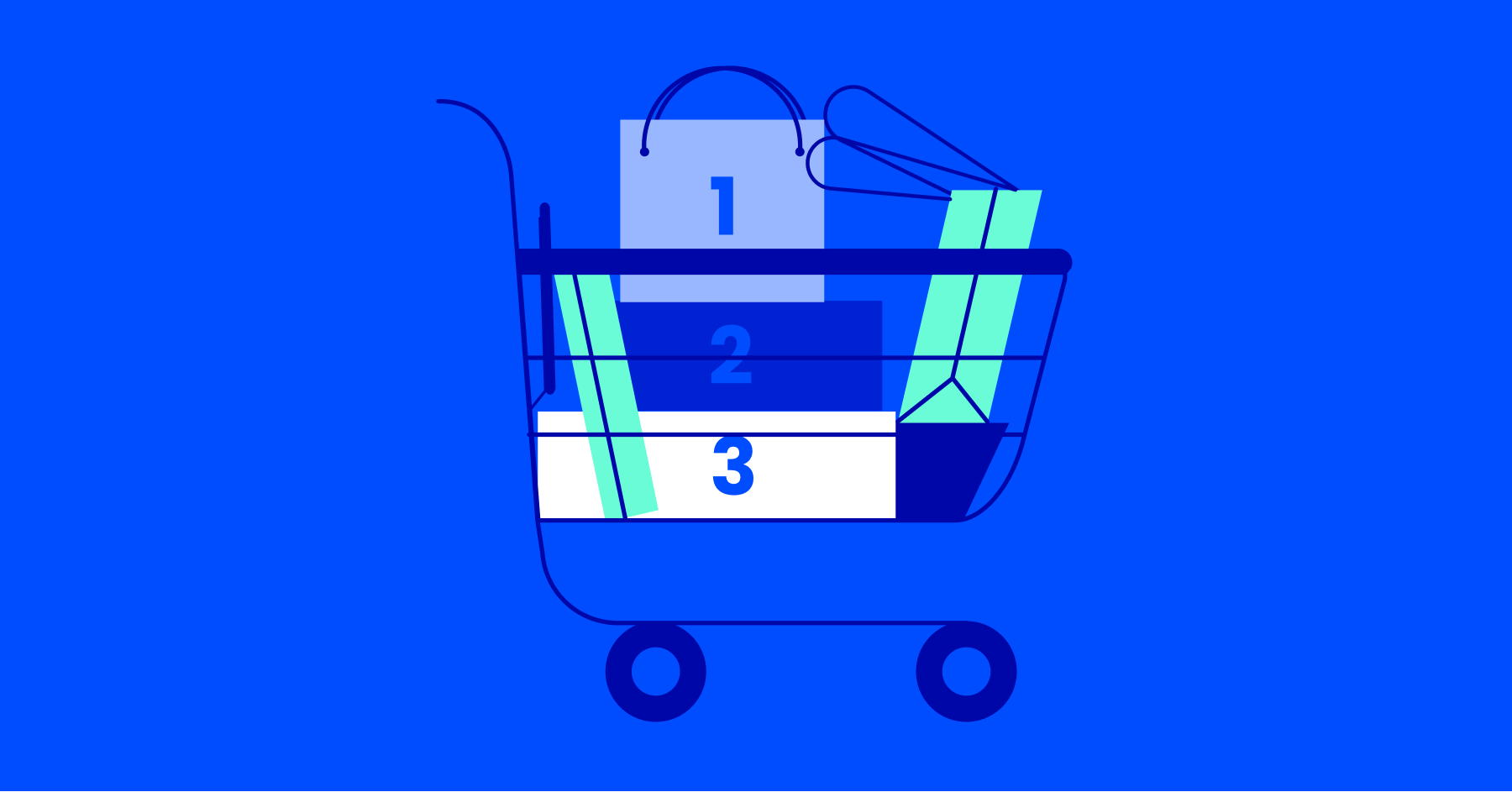Bad news first, or good news first?
(Actually, in this case, it kinda has to be the bad news. Sorry!)
Over 75% of people abandon their shopping carts online. In your ecommerce store, 3 out of every 4 people who add something to their cart leave without paying you.
That’s the bad news. The good news is, you can…
- Get a bunch of them (10% or more) to come back and buy
- You can set up that system once – and get results from it with no extra work
What makes a cart recovery email strategy so special?
The average ecommerce email open rate is around 15%. Abandoned cart emails laugh in the face of that number — they boast nearly a 45% open rate.
I just went and abandoned 50 carts. Because I wanted to see exactly what types of abandoned cart emails people are sending.
And I wanted to show you the best examples of abandoned cart emails.
Once you learn how much abandoned carts cost you with our free abandoned cart calculator, you can start using these same cart abandonment solutions to recover up to 63% of your lost sales.
In this blog post, you’ll learn:
- What are abandoned cart emails?
- Why do people abandon online shopping carts?
- What 12 strategies should you use in an abandoned cart email?
- When should you send your abandoned cart emails?
- Why should you send an automated series of abandoned cart emails?
What is an abandoned cart email?
An abandoned cart email is a follow-up message sent to someone who leaves a website without purchasing the items in their online shopping cart. Abandoned cart emails are typically sent to people who leave part-way through checkout, and can recover around 10% of lost revenue.
An abandoned cart email is meant for the 3 (out of every 4) shoppers who leave a website without finishing the checkout process.
The huge benefit of abandoned cart emails? They’re automated. You can set up a series that goes out all on its own – and wins back revenue that would otherwise have disappeared.
If you’re not convinced — the numbers don’t lie (Source: Moosend):

Consider these abandoned cart statistics:
- 45% of all cart abandonment emails are opened
- 21% of all cart abandonment emails are clicked
- 50% of those clicks lead to a recovered purchase back on site
There are oodles of different types of emails you can send your customers. But with numbers like that, cart reminder emails give some of the highest return on your investment.
Ok, you’re sold. Next step — why do people abandon carts in the first place
Why do people abandon their carts?
Common reasons people abandon online carts include:
- Distractions
- They forgot
- Price or shipping costs
- Website issues
- Complex checkout process
- Return or exchange policies
- Comparison shopping
- Just browsing
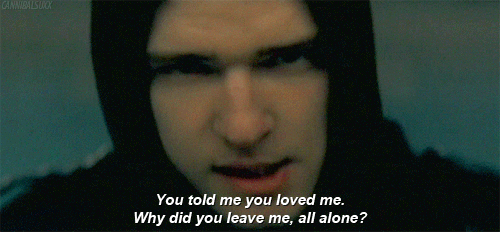 Justin Timberlake was definitely singing about your abandoned shopping cart’s feelings.
Justin Timberlake was definitely singing about your abandoned shopping cart’s feelings.
Some abandoned shopping carts you can’t do anything about. Some people are just browsing or comparison shopping – they were never going to buy.
Don’t worry about those people. There are people you can coax back – the ones who just got distracted or confused by your checkout process.

Here are the top reasons for cart abandonment that you can do something about:
- Extra costs are too high. Explore ways to reduce shipping costs by using cheaper packaging or by changing mail carriers
- Forced to create account. Many sites that offer the option to create an account still allow people to check out as a guest
- Long checkout process. Is your checkout process too complex? Find steps you can combine or even cut completely.
- Can’t see total costs. Display updated cart totals at every step of the checkout process
- Didn’t trust the website. Show your ecommerce security credentials with a badge. According to the University of Reading, 23% of shoppers have abandoned a purchase because they didn’t trust website security.
- Website errors or crashes. Sometimes crashes are beyond your control, but there’s no excuse to not test your website across multiple browsers and devices
- Delivery estimate too slow. In the era of next- or same-day delivery, customers expect quick turn-around
- Strict return policy. A generous return policy will make up for the inconvenience of extra returns through increased sales you’ll make over time
- Lack of payment options. Some people refuse to use paypal while others use nothing but. It’s easy to accommodate both.
- Card declined. Most ecommerce platforms allow you to make a pretend purchase with fake credit card numbers to test your checkout process
What about your abandoned carts? Learn more about why people leave your checkout process through:
- Google analytics: Explore the customer journey on your website to find where they’re dropping out
- Research: Know your audience and their expectations of similar products and purchasing paths
- Surveys: Ask customers through an email survey about your checkout flow and their purchasing intent to discover pain points you can address
- Heat maps and click maps: Learn how users really behave by seeing where they click on a page, how far they scroll, and the graphical results of eye-tracking tests
Rehab your online store to remove many of the reasons people abandon their carts. Now you have pinpointed the remaining reasons — and can convert those lost sales using the answer to one important question:
What made your product so awesome they put it in their online cart in the first place?
12 examples of abandoned cart emails: what makes them good (and what can make them even better)
Here are the 12 best strategies to use in your abandoned cart emails:
- Build a well-crafted subject line (Evil Queen)
- Give a clear call-to-action (Bearsville Soap Company)
- Make your copy shine (ThinkGeek)
- Show your product (ThredUP)
- Create catchy graphics (SugarBearHair)
- Create a sense of urgency (Google Store)
- Offer alternatives. Well, maybe… (Vans)
- Address potential objections (Whisky Loot)
- Use reviews and social proof (Brooklinen)
- Offer a coupon, but only at the right moment (Lime Crime)
- Optimize for mobile (LUSH)
- Keep it simple, with one call to action (Quip)
After seeing how these strategies are used in the following examples, you’ll be ready to make abandoned cart email templates — and can start to recover sales from people who abandon carts at checkout.
1. Build a well-crafted subject line
“He fretted over the words, attempting to make the content meaningful. I can remember his saying over and over again, as he worked at the fourth or fifth draft of whatever he happened to be writing, “Simple is better.” — Joanne Rogers, in her foreword to The World According to Mister Rogers.
What can Mr. Rogers teach you about how to write a great abandoned cart subject line?
As he said, “Simple is better.”
64% of people decide if they will open an email based on the subject line. If you want to be noticed over the cascade of emails in someone’s inbox, you need to make your message instantly understandable. And pull out your best cozy sweater, because a big part of that depends on your tone.
Think friendly. Think conversational. Think…Mr. Rogers.
 Mr. Rogers likes you just the way you are, and he thoughtfully brought the stuff you left behind in your cart, too.
Mr. Rogers likes you just the way you are, and he thoughtfully brought the stuff you left behind in your cart, too.
What information should you include in your abandoned cart reminder subject line?
- Company name: Let them know who is contacting them
- Customer name: Email personalization may help you get opens
- Friendly tone: If you can’t imagine Mr. Rogers saying it, rephrase your subject line
- Product name or details: What exactly did they leave in their cart? Remind them.
- Urgency: If they might lose the items in their cart, let them know
- Simplicity: Because the decision to open your email is made within seconds
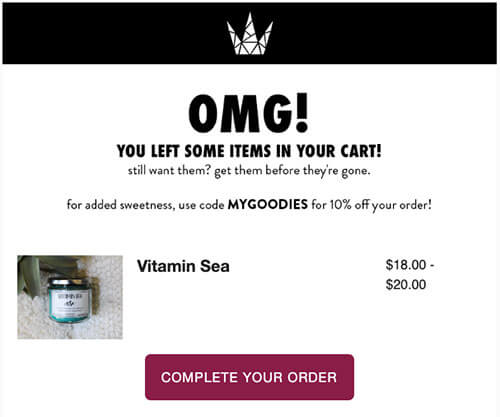
These are examples of real abandoned cart email subject lines I received:
- Finch, we’ve saved your cart 🤙
- Did you forget about me, Finch? 😱
- We’re ready if you’re ready.
- Lemme Teleport You Back To Your Cart. Free of Charge.
- Your electric toothbrush is waiting (with a free refill).
- Finch, your cart is wondering where you went ❤️
- Your cart MADE us send this reminder 🙂
- Is your wi-fi ok?
What do all these subject lines have in common? They’re not demanding anything of you. They’re just simply checking in.
2. Give a clear call-to-action
An email call-to-action (CTA) is a link or button designed to get a prompt response from the person seeing it. But remember this childhood lesson: ask for what you want nicely.
That means lowering the stakes of what your CTA is asking of your potential customer.
Which of these buttons is best?
- Buy now
- Pay some of your hard-earned cash
- Return to your cart
In general, avoid words like “buy” or “pay” in your CTAs. These are “high-friction” words, because they suggest doing something that the person might not be ready to do.
A CTA like “return to your cart” gets people to take the next step (clicking) before the sell.

What this abandoned cart email does right:
- The low-friction call-to-action emphasizes how easily the customer can finish the checkout process they started…if they’d like to.
- The bear emoji in the subject line is charming, reinforces their branding, and will stand out in your inbox
- The tagline for Bearsville is “Soap for Men,” and is made from natural ingredients in the Catskills. Using imagery of fashionably bearded manly men is aspirational, selling an idea of the kind of person that uses their product.
What this abandoned cart email could do even better:
- Product shot could be more prominent. With a great photograph to grab attention, the cart recovery product shot is overshadowed. It could benefit from a larger thumbnail and some descriptive copy.
- Customer reviews. Soap is a product that lends itself well to reviews (since you can’t smell soap through your inbox)
3. Make your copy shine
Here are the three points you need to make in your abandoned cart email copy:
- They liked something enough to put it in their basket
- It was left in their online shopping cart
- They should return and complete their purchase
Everything you should include in your email is a means to that end.
Like with your CTA, use a casual tone in your copy. The last thing you want to do is barge into a potential customer’s inbox with a bad attitude and an entitlement complex.
Your personality should shine through every piece of your marketing content, including cart abandonment emails. Recover sales by being distinctive in a cluttered inbox.
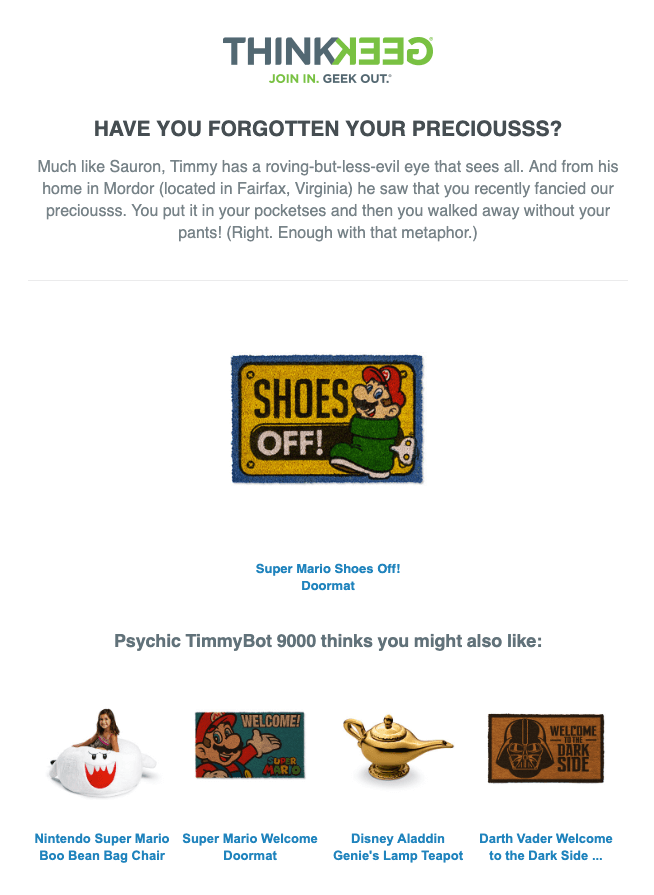
What this abandoned cart email does right:
- ThinkGeek’s catalog caters to “nerd” culture, such as video games, comic books, and fantasy. Their copy (and subject line) reinforces their branding, with a playful take on Lord of the Rings. If your store’s personality is highly marketable, use it.
- This is a concise email. It can be tricky to get your brand persona across so succinctly, but ThinkGeek does it.
What this abandoned cart email could do even better:
- A CTA button leading directly to their cart. With the same humorous language, this would get more attention and streamline the purchase flow.
- “Related” items aren’t. It’d be better if all the shown “related items” were actually related.
- Clearer support. Info on how to reach out to “Psychic TimmyBot 9000” for customer service help or directions back from Mount Doom would have been a great touch.
4. Show your product
Showcase exactly what was left behind in your customer’s cart. Don’t conceal that information — reveal it like you’re Vanna White on Wheel of Fortune.
People might not remember what products had them clicking the “add to cart” button. If they open your email and are still confused, they’re probably going to delete the email – and you’ve lost a potential sale.
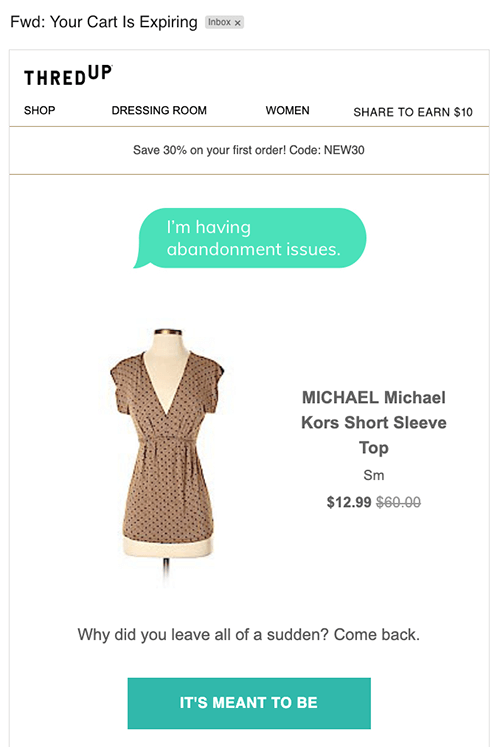
What this abandoned cart email does right:
- The clothing is front and center: there’s no question what item was left behind
- The CTA button is playful and flirty, a winning combination for ThredUp’s branding
- The word-bubble above the abandoned cart item joking about feeling abandoned is a clever design element
What this abandoned cart email could do even better:
- More interesting subject line. Shopping cart, we’re all expiring. This subject line stands out as being generic and impersonal. It could be about anything…or nothing at all. How existential.
5. Create catchy graphics
No biggy. It’s not hard to get your emails noticed. It’s not like over 250 billion emails are sent every single day.
Your subject line, CTA, and email copy can make or break your ability to convert abandoned carts into a sale — but graphic elements will often be your audience’s critical first impression.
What are some tips to design a great email?
- Pull your website theme and a condensed menu into your email designs. A consistent, cohesive look reinforces your branding.
- Be careful with stock images: people have become savvy at detecting generic photography. If possible, use elements created especially for your campaign.
- A dynamic design — like a slideshow or an animated gif — can add energy and interest to your email.
- Use color thoughtfully. Color evokes mood: our brain is hard-coded to respond in certain ways to viewing certain colors. If you have brand colors, bring them into play.
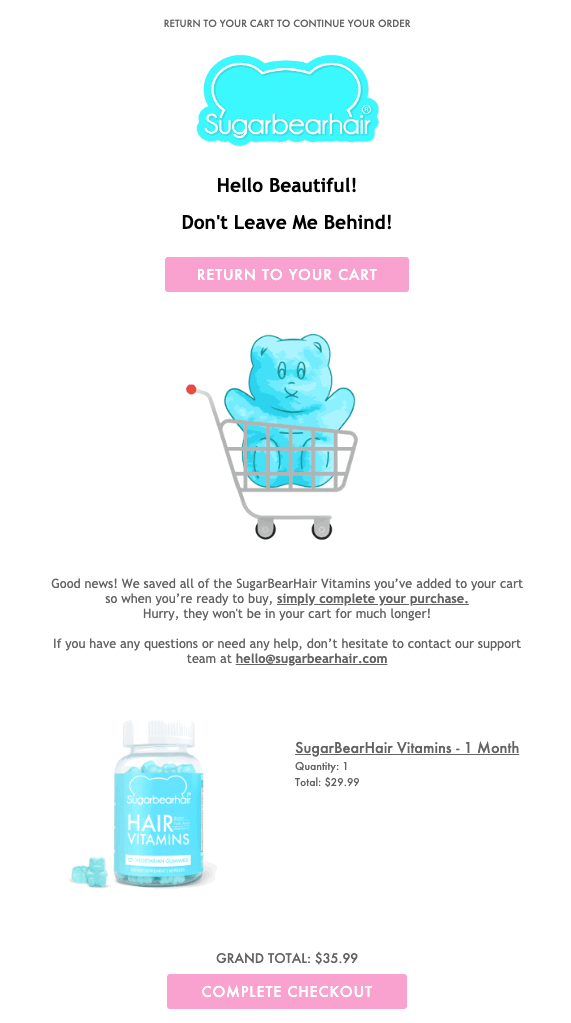
What this abandoned cart email does right:
- Americans spend more than $30 billion a year on dietary supplements. SugarBearHair stands out from the crowd with playful graphics like this illustrated gif, which get people to keep looking at their emails.
- The blue hue they chose unites the graphic design with the color of the gummies, and the contrasting pink makes the CTAs pop
- Customer support is offered up front, a smart choice when your product is about health benefits
What this abandoned cart email could do even better:
- Customer reviews. With so many vitamins on the market, user reviews would be a welcome addition to SugarBearHair’s abandoned cart email copy.
- Be specific using urgency. “Hurry, they won’t be in your cart for much longer.” Why? Are my gummies going on a yoga retreat in New Mexico? Be specific, because as you’re about to learn, urgency can be a powerful motivator…or can make people think you’re dishonest.
6. Create a sense of urgency
People pay more attention to what they might be missing out on than what they’re able to get. The FOMO is real.
Alerting potential customers that they might lose the items they’ve placed in their cart is a great way to tap into the scarcity effect as a marketing tactic, as long as you’re honest.
(Read our article on loss aversion to correctly use this abandoned cart email strategy to increase your recovery rate.)
Here are some popular ways to use urgency in your emails:
- Let people know if their item is likely to sell out due to popularity
- Reserve their cart for a limited time (with a countdown)
- If your item is limited edition, make clear that it won’t be restocked
- Set an alert showing how many other people have the item in their cart

What this abandoned cart email does right:
- Google Store isn’t here to soothe your FOMO: they make it very clear that their items are in high demand.
- They clearly offer multiple options to reach customer support. Bonus points for including the hours they’re available.
- Simple = high-quality in people’s heads, a phenomenon Google Store taps into with this design.
What this abandoned cart email could do even better:
- CTA could pop more. Use a contrasting color, or have a second CTA placed near the product shot thumbnail.
- Customer reviews. People like reviews…especially when choosing electronics and computer equipment.
7. Offer alternatives. Well, maybe…
Will these sneakers change how I feel about myself? If I feel different, will I act different? Oh man, maybe I should buy blue instead of red. I don’t think I want to deal with the pressure of being a red sneaker person.
People might have abandoned their shopping cart because they were unsure of their choice — maybe the item isn’t exactly what they had in mind. But, they might be sold on similar items they missed the first time.
But don’t overwhelm the original item they put in their cart. A shell-game switcheroo may lose your customer completely — they liked that item enough to put in their online cart for a reason. Alternatives should support their great taste.
Here are ideas for related items to include in your cart recovery email that won’t distract from the primary focus:
- Offer up accessories for the main item
- Show different patterns or colors of the same item
- If your products are at a lower price point, popular sellers can be value incentives to reach free shipping thresholds
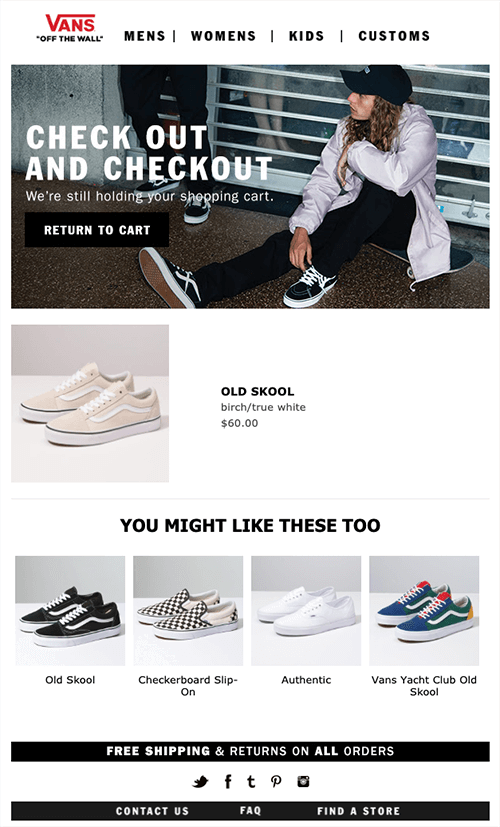
What this abandoned cart email does right:
- Maybe you would like those checkerboard sneakers, now that you’ve seen them. Note that Vans doesn’t say “instead.” They say you might also like the other options they present.
- Vans uses a stripped down look that mirrors the layout of their online shop (brand consistency)
What this abandoned cart email could do even better:
- Those are not the shoes I put in my cart. The same style, yes, but in a completely different color. Always test your emails before setting them free into the wild (either by sending them to yourself or another trusted set of eyes).
8. Address potential objections
There’s always reasons not to do something. I can easily think of 37 reasons to avoid doing pretty much anything. Tackle objections up front. If you can dispel arguments against buying before people even think of them, you’re more likely to recover lost sales.
Address potential objections by doing customer research and website usability testing. Understand what concerns your customer might have, and you can uncover ways to address those issues directly in your abandoned cart email.
You can learn more about uncovering objections in this article on market research.
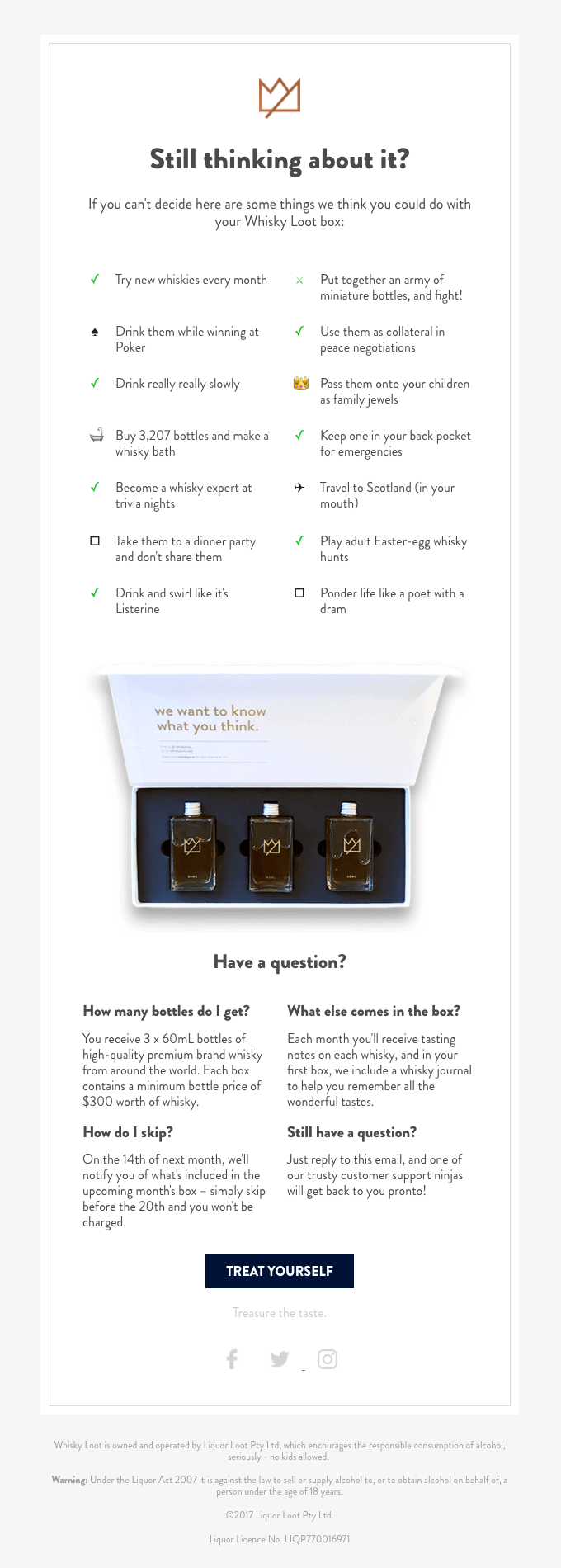
What this abandoned cart email does right:
- Whiskey Loot is straight-up challenging you to think of an objection they haven’t already addressed. And if by some chance you can actually think of one, they’ve made it easy to reach out with further questions.
- The copy of this email is so delightful, it’s easy to forget it’s actually marketing
- If you have a lot of copy, your design choices matter even more. Whisky Loot doesn’t waste a pixel of space in this email — but still presents it in an uncluttered, appealing way.
What this abandoned cart email could do even better:
- Product shot closer to CTA. Other than showing what was in the customer’s cart next to the “Treat Yourself” CTA, there’s not anything they could add that would further serve their chosen abandoned cart solution.
9. Use reviews and social proof
Do you laugh along with coworkers when the boss makes a cheesy joke? If a group of people are looking at the sky, do you glance up too? Do you get a thrill when someone likes your posts on social media?
Have you ever asked for opinions from friends when considering dropping some cash — on a new couch, which restaurant to try, or how your butt looks in those jeans?
91% of people read online reviews. Social validation is proven to affect online purchasing decisions. Social proof is even one of the six “principles of persuasion” outlined by legendary psychologist Robert Cialdini (in his book, Influence).
Convert the unconvinced with reviews.
- Go through your reviews and pull the best ones to include in your abandoned cart email
- If you don’t have any reviews, reach out to your customer base (especially any True Fans)
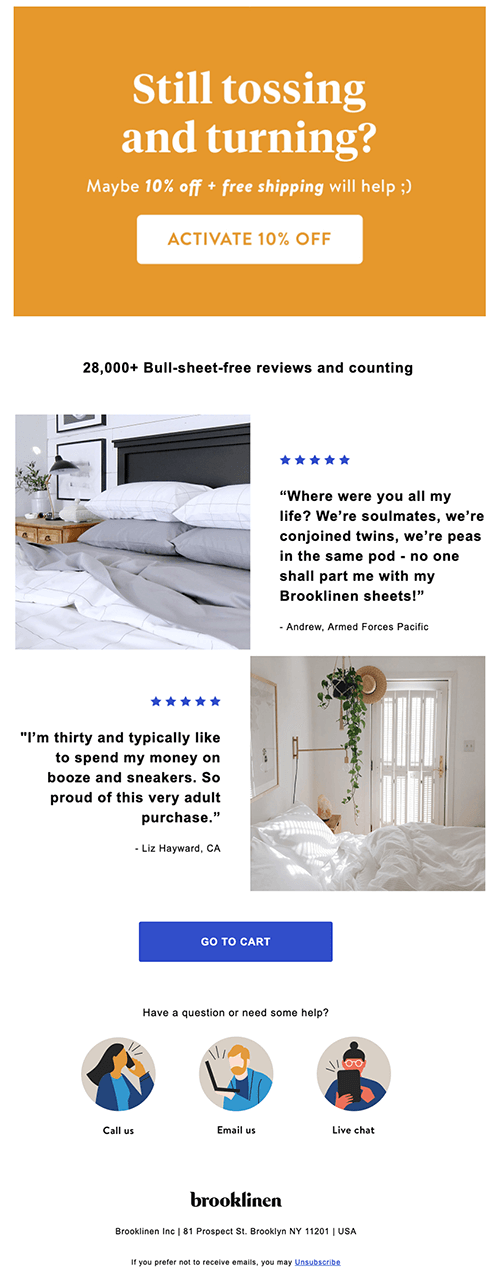
What this abandoned cart email does right:
- Brooklinen backs up their tagline “Really Good Sheet” by showcasing 5-star reviews. This confirms that the items left behind are worth buying.
- The ways to reach customer support are boldly highlighted with illustrated spots that add a spark to the design
What this abandoned cart email could do even better:
- Hold on the coupon. Don’t offer discounts right out of the gate — you don’t want your potential customer to wonder why you “need” to offer a discount if your reviews are so good.
10. Offer a coupon, but only at the right moment
A coupon discount is the Frankenstein’s monster of adding value to an abandoned email. Tread lightly, or your creation can destroy you.
We’ve discussed the risks of abandoned cart coupons before. Coupons are dangerous because:
- You don’t want to teach a customer that your product is not worth your price. Why reward people who’ve no investment in the success of your business?
- They cost money! You might trade your margin (and lose money on a sale) for nothing
- You might offer a coupon to someone who would have been happy to pay full price
In Confessions of an Advertising Man, David Ogilvy writes, “A cut-price offer can induce people to try a brand, but they return to their habitual brands as if nothing had happened.”
So how do you use coupons without devaluing your product or slowing growth?
- Add value before considering a discount strategy. Push the button on another psychological sales trigger. Do you offer free shipping? Do you have killer reviews? What about a money-back guarantee? Loyalty program incentives? These are all ways to showcase value that doesn’t devalue your product.
- Offer coupons to proven customers. Single-use coupons sent to repeat customers is a great way to make a sale…and build loyalty
- Save your discounts for the end. If you send an email sequence, save that coupon code for the very last one. This is your last shot at getting the customer to convert, after all.

What this abandoned cart email does right:
- Lime Crime waited until the third abandoned cart email to offer a discount. The reminder that there’s free shipping over $50 is another value incentive.
- The copy and CTA hit the perfect note for a company whose tagline is “Makeup for Unicorns”
What this abandoned cart email could do even better:
- Mobile design. This email looked great on my laptop, but on my iPhone it fell apart since it wasn’t a responsive design. That brings us to the next cart recovery strategy in our list…
11. Optimize for mobile
Today, 61% of all emails are opened and read on mobile devices.
If your email isn’t mobile-friendly, it’s probably going to be deleted in under three seconds.
Up to 15% of those recipients don’t just delete your email…they unsubscribe completely.
Americans check their phones an average of 50 times a day. Test your emails on mobile, because chances are that’s where they’ll first be seeing your message.
Best practices for mobile email design include:
- Space-saving menus. Less is more when it comes to mobile, so keep it concise
- Mobile-friendly content. Oversized images that don’t scale will frustrate your customer
- Responsive design. Multiple columns or dense copy will break your design
- Sticky CTA button. A button (instead of a link) that follows as you scroll makes for a frictionless cart return
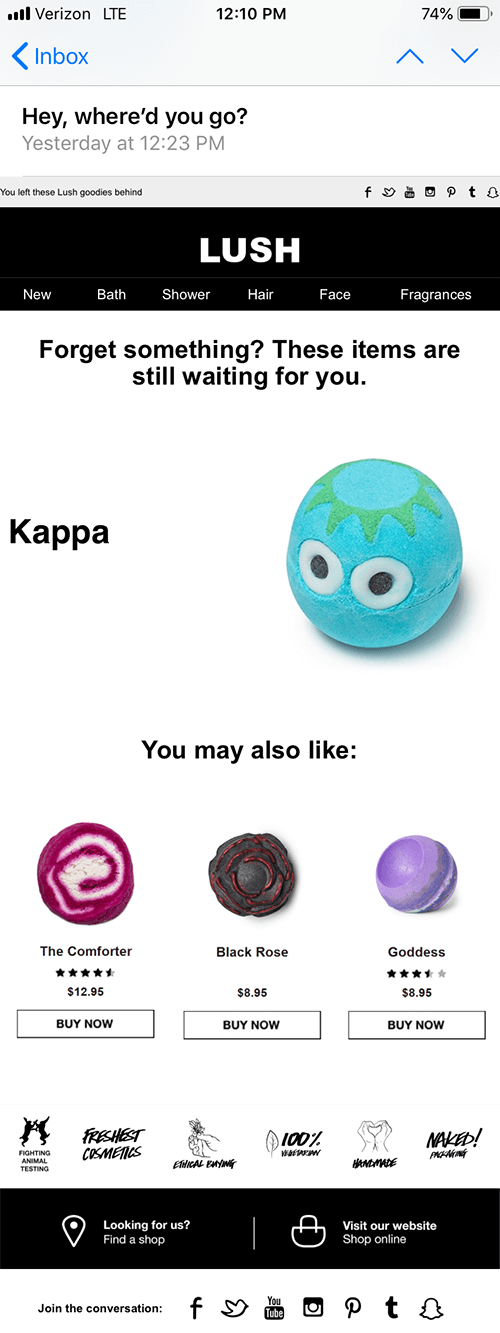
What this abandoned cart email does right:
- LUSH is a great experience on mobile. Easy to navigate.
- Do you see how cute that bath bomb is? Of course you do — it’s vividly showcased. There is zero question in the customer’s mind about what they left behind.
- When you have low-cost products, showcasing other options can be smart, especially if you offer free shipping when the order value reaches a certain threshold
What this abandoned cart email could do even better:
- CTA next to product shot. A clear CTA button next to the abandoned bath bomb would be the perfect way to complete this great email
Here’s a bonus idea for you — reach outside of your potential customer’s inbox and text them a reminder.

There’s a risk that your text reminder will be seen as intrusive, so test this carefully. Only send one text. If most people reply “stop,” it’s not the right strategy for your business.
12. Keep it simple, with one call to action
With so many options at your disposal, it can be tempting to throw them all into your abandoned cart email template and hit the blender. Don’t. Holiday fruit cakes are the butt of jokes for a good reason.
You can’t effectively use every single strategy in your abandoned cart email. Some methods will work better depending on your specific product and customer base. Try adding a single strategy at a time to test and track your response.
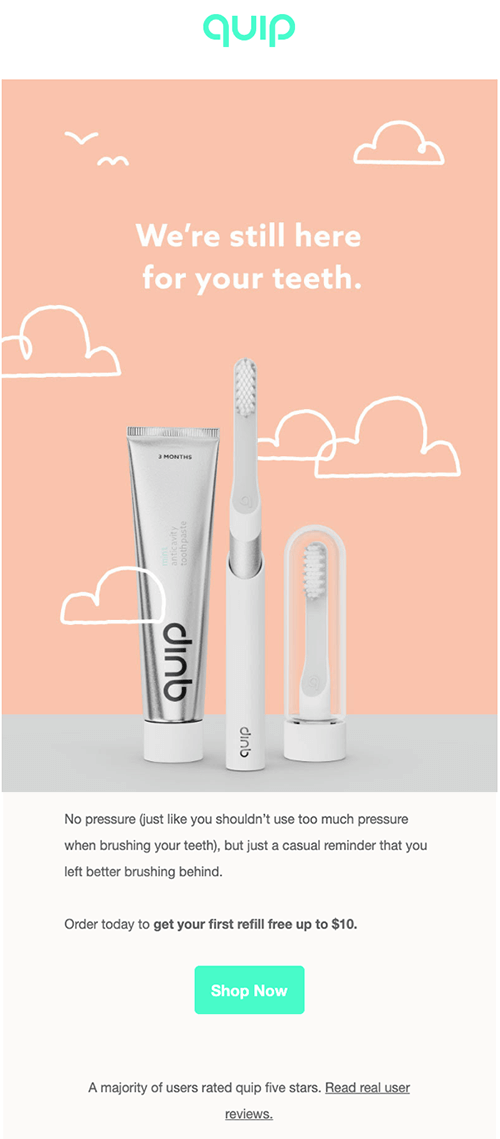
What this abandoned cart email does right:
- This abandoned cart email is not overcrowded with tactics that don’t support Quip’s message. This simplicity translates as confidence in their product.
- The design choices are soothing, warm, and welcoming. The hand-drawn cloud elements add a human touch.
- The use of punny copy to reinforce there’s no pressure to buy is charming and clever
- Quip points out that the majority of their users rate them five stars
- The CTA pops, with a clear message that invites you back, instead of demanding
- Value is added not with a coupon, but by reminding the customer that their first order includes a free refill
What this abandoned cart email could do even better:
- Address objections. This email truly wants for nothing, but if we had to nitpick, we’d suggest a way to reach out to customer support
How to time your cart recovery emails to make the most impact
How to time your cart recovery emails to make the most impact
When you’re deciding how to reduce shopping cart abandonment, timing matters.
How much? According to SalesCycle’s research, timing affects conversion rate. Emails sent:
- In less than an hour achieved on average a 3% conversion rate
- An hour later was the sweet spot, at an average 6.3% conversion rate
- Sent at 24 hours after a basket was abandoned achieved on average a 2.5% conversion rate
A timed series of three cart recovery emails is the most effective way to convert customers from a “maybe” into a “yes.”
Here’s what to keep in mind when designing an abandoned cart email campaign:
- Make sure each email in your series is unique
- Focus on only one or two different strategies per email
- If you want to offer a discount coupon code, wait until the last email in your series
Look at this series of emails from Casper. An hour after I decided I wasn’t sure if I wanted to purchase a mattress, they sent this:
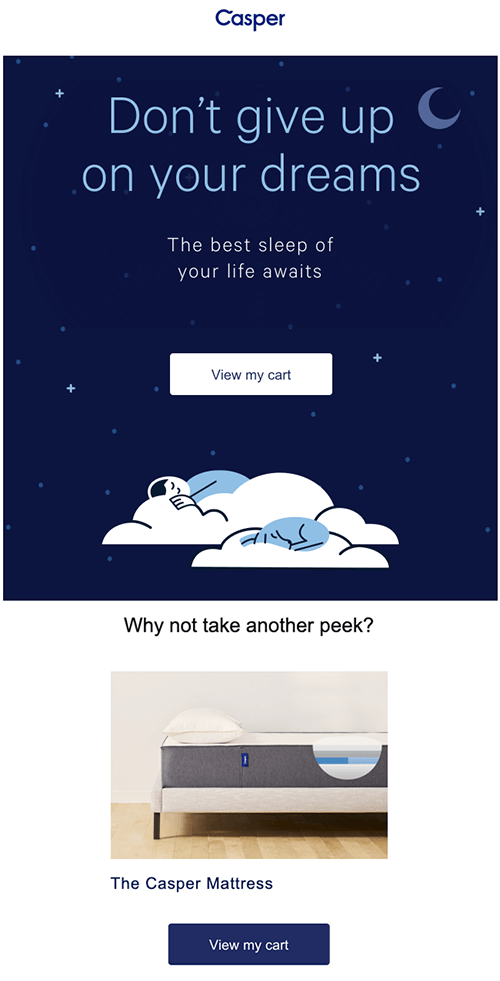
This email included:
- Multiple clear CTAs
- Simple design with charming graphics
- What I left in the shopping cart
This recovery email’s focus is simply to remind me I forgot my online shopping cart.
Twenty-four hours later, I got this follow-up email:
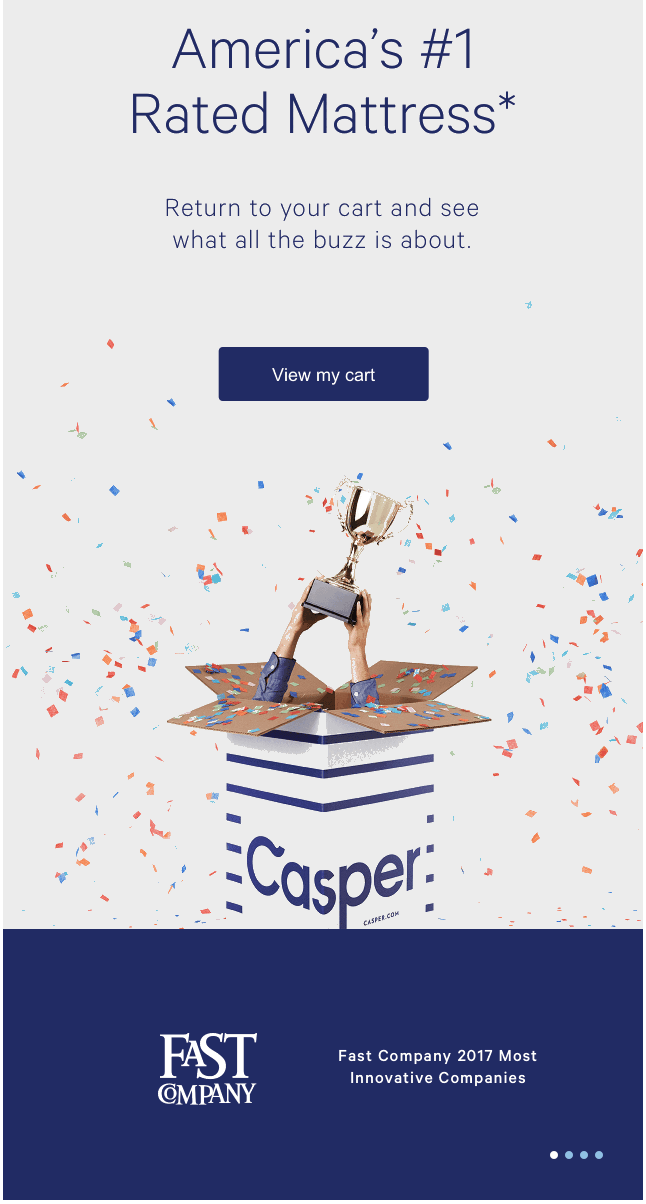
In this second email, Casper chose a recovery strategy of showcasing their great reviews. They are addressing concerns that stop me from pulling the trigger. Shoppers trust reviews nearly as much as their friends.
And then, after another twenty-four hours, they finished their series with this third email:

To wrap things up, Casper:
- Showed me one final time what I had left in their cart
- Chose a design using a real person, so I will imagine myself being that cozy
- Offered a discount incentive (notice they waited til now, and not earlier)
This is their last attempt to convince me — further emails would seem desperate and annoy me (if I haven’t bought by now, I’m probably not interested).
Has Casper cracked the code on how to convert abandoned carts? Well, Casper went from 0 to $750 million in four years. A piece of that success is finding recovery solutions to lower cart abandonment rates.
How can you create your own abandoned cart email sequence?
In ActiveCampaign, you can:
- Trigger automations when a cart is abandoned
- Schedule when each email goes out
- Integrate those automations with Shopify, WooCommerce, and BigCommerce
We even have an article that will walk you through setting up an ActiveCampaign abandoned cart series.
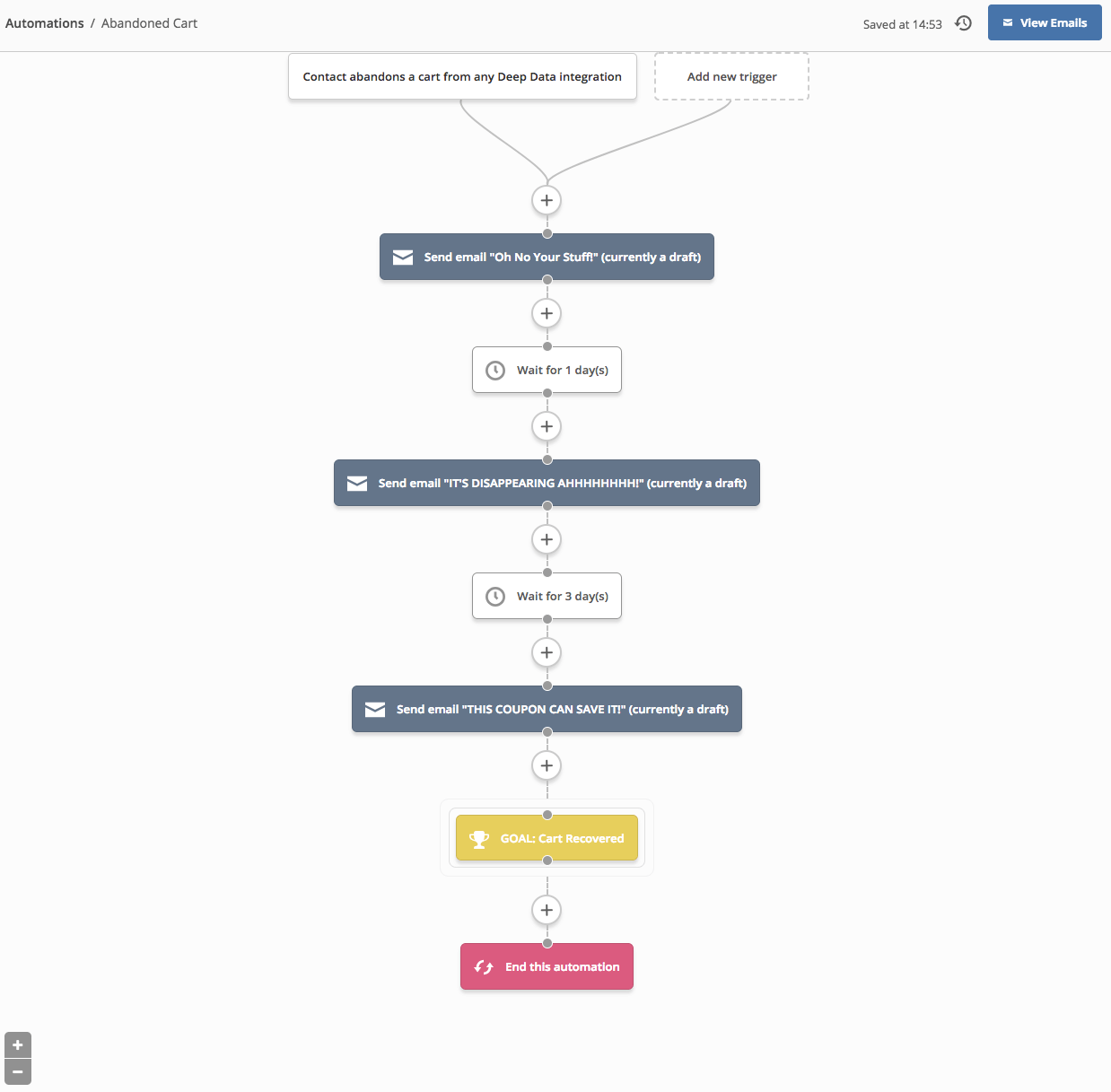 ActiveCampaign makes sending an automated abandoned cart series easy-peasy.
ActiveCampaign makes sending an automated abandoned cart series easy-peasy.
I abandoned 50 carts while doing research for this post.
Of the 50 carts I abandoned, only slightly over half sent a cart recovery email, even though they’re remarkably effective as a sales recovery tactic. Of those, half sent two emails. And only a handful sent a series of three, even though they provide the best conversion rates.
I can’t even remember the websites I shopped at when researching this article…unless they sent me a recovery email.
Do you want to be that easily forgotten?
A great cart recovery campaign can make people remember you. 75% of shoppers plan on coming back to their abandoned cart. Quickly change their “plan” into “did” with abandoned cart emails that work. Start turning missed opportunities into recovered sales.
Go forth, and shed your abandonment issues!
